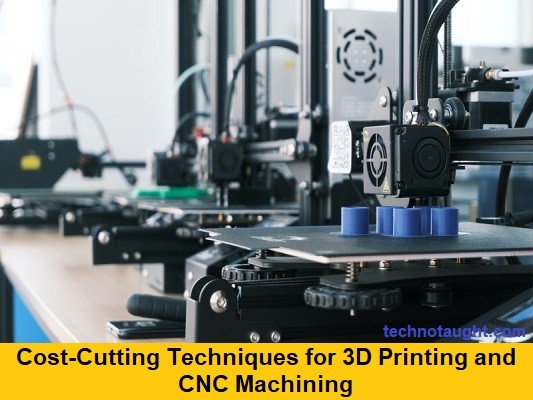In this article, we will see the top Cost-Cutting Techniques for 3D Printing and CNC Machining
3D printing has proven to be a fascinating innovation for thousands of manufacturers, engineers, and developers for years, and now it has become an indispensable asset to every manufacturing unit. Add CNC machining to the mix, which, when combined with 3D printing technology, is a more efficient approach to production and is rapidly becoming the method of choice in a wide range of industries.
A notable benefit of CNC milling is the reduction of manual labour during the various stages of manufacturing. On the other hand, inputs from a CAD software system to direct a milling machine, lathe, or any other machine to perform processes automatically allow the manufacturing process to improve significantly in terms of efficiency, cost, and speed. This combination of 3D printing and CNC machining is like the best of both worlds.
A CNC machine and 3D printer are the best choices for industries like the automotive and aerospace sector, maritime industries, the medical field, and more, but using both the applications at the same time, can get quite expensive for production. So, what can you do to keep your production costs low?
There are several ways to cut down on CNC machining costs, some of which occur during the machining processes. Whereas every stage of the 3D printing process, from design to post-processing, comes with a hefty price tag. However, there are ways to make sure you’re getting the most return on your investment. Here are some tips you can use to save on 3D printing so that you can let your imagination run wild. So, let’s review those first before jumping off to CNC machining.
React More: – How to Start Your Own Tech Business
Cost-Cutting Techniques for 3D Printing and CNC Machining
Cost-effective Measures for 3D Printing

- Look for Suitable Materials for your Project- Look for suitable materials and technology for your 3D printing service that suits your budget and needs. Metals, ceramics, and plastics are among the materials available for printing. The price difference between various materials is substantial. Pick the appropriate material early to get a faster and more successful 3D printing project, saving time, material, and money.
- Consider Optimizing your Print Settings- Always utilize optimal print settings if you want superior print quality. It’s critical to enter the optimum settings for your printer and chosen filament when using slicing software to prepare your print. Proper settings result in higher-quality prints. It also minimizes the likelihood of print failures, blocked nozzles, and other unpleasant experiences that will have you redoing the process, wasting excess cash.
- Hollow Out your 3D Model- Consider this tip unless you plan to 3D print a solid bowling ball. It is possible to save on material and reduce printing costs if you hollow out the inside of your design. Remember that the printing material requires a minimum wall thickness to maintain structural integrity. Plastics and ceramics can range from 3mm to 1mm, while titanium can go down to 0.2mm.
- Make your Print Smaller- The idea that “bigger is better” might not make sense for businesses looking for ways to minimize their 3D printing expenses. If you intend to print a life-size model, it is better to reduce the size of your design. Like this, the printing process will use less material, resulting in significantly lower 3D printing costs.
Cost-effective Measures for CNC Machining

- Material Selection Matters- The material you choose affects CNC machining costs in two ways. As a first step, raw materials are expensive, and the material you choose will largely depend on your application. A second factor that affects pricing is the machinability of the raw material; the smoother the material is to process, the lower the cost – and the more difficult it is to machine, the larger the wear on consumables, such as tools, and so the expense will rise.
- Make Sure Your Design is Simple- One of the most notable benefits of adopting 3D CAD software is that the designer can spot difficulties in the machining area early in the design process. If the design streamlines the manufacturing process, CNC machining will be easier. CNC machining is also more accurate than traditional machining. So, if the item is designed correctly, there will be less waste. Another cost-cutting feature of CNC is the built-in feature of removing human errors.
- Keep an Eye on Treatments and Finishes- Surface finishes may include the smoothness of parts or treatments to enhance the material performance. CNC machined parts can achieve substantially better surface finishes than 3D printed parts. However, this will necessitate the use of additional procedures. Accepting a component with the machined finish and buffing it in-house if you have the capacity is more cost-effective if it is merely functional. While plastic parts are typically supplied as machined, metal parts require trimming and additional tools to machine corner sections where the design includes an edge break. This makes sense for flattening down edges and avoiding sharp edges, but it increases machining time and thus expense.
Read More: – How to Attract Talent-A Take on Business Leadership
Wrapping Up
Both CNC and 3D printing are sophisticated and productive manufacturing cost-cutting techniques that are gradually penetrating a wide range of industries, and the methods listed above are only a few of the options available to keep costs as low as possible. However, you can only take advantage of these technologies if you have a simple product design on hand. A basic and well-crafted design will cut down on the time it takes to make the parts and eliminate any potential errors.
Let us know in the comment section if you have any problems related to top Cost-Cutting Techniques for 3D Printing and CNC Machining.



